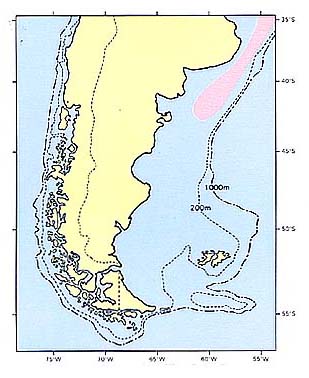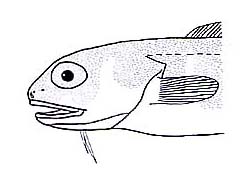アシロ科
- HOME
- デジタル図鑑
- パタゴニア海域の重要水族
- 硬骨魚綱 アシロ目
- アシロ科
アシロ科(Ophidiidae)

46 ミナミシマアシロ(Minami-shimaashiro)
Raneya brasiliensis (Kaup, 1856)
特 徴:
全長に対する体高の割合は12.5~13.1%,頭長の割合は18.8~19.6%。頭長に対する眼径の割合は28.0~30.3%,両眼間隔は22.4~26.6%,吻長は23.5~25.7%,上顎長は40.8~43.3%,胸鰭長は41.5~43.3%,腹鰭長は21.7~30.7%,背鰭高は16.5%,臀鰭高は11.2%。体はやや側扁する。尾端は丸い。吻は円鈍。吻の上部,両眼の前方の中央部に皮下に埋没した鈍い1棘がある。鼻孔は吻の前端に開く。眼は大きく,眼径は頭長の1/3~1/4。口はやや小さく,上顎の後端は眼の後縁下を越えない。下顎は上顎下に含まれ,上顎歯の前部は露出する。両顎歯は絨毛状で歯帯を形成する。鋤骨に歯がある。鰓耙は細長く,上枝に2本,下枝に5本ある。胸鰭は小さく,その先端は丸味をおびる。腹鰭は喉位で,2対の糸状物からなる。背鰭は胸鰭起底よりやや後方から始まり,臀鰭は体の中央よりかなり前方から始まる。背鰭と臀鰭は尾鰭と連続する。側線は体側上方を小さく波打ちながら,背側に沿って平行に走り,尾鰭基底の直前で終る。有孔側線鱗数は約47枚。体側に約10本の太い茶褐色の横帯がある。背鰭,臀鰭,尾鰭の縁辺は黒く縁どられる。
分 布:
ブラジルのリオデジャネイロからアルゼンチン北部(ボナエレンシス海域)の大陸棚上(水深40~150m)に分布する(Figueiredo and Menezes, 1978)。
備 考:
本種は体に横帯があること,吻の上方の中央部に1棘があることで,他のアシロ科のGenypterusやOphidionと区別される。種名は従来,R. fluminensisが用いられたが,Robins(1985)によりR. brasiliensisが正しいとされた。
(稲田伊史)
Material examined:
2 from Argentina (147.3-222.0 mm TL), FSFL EL 810; EM 53.
Description:
D 135; A 105; C 9; P1 21; GR 7; Ⅴ 26. HL 18.8-19.6 % of TL, BD 12.5-13.1; ED 28.0-30.3 % of HL; SN 23.5-25.7; IO 22.4-26.6; UJ 40.8-43.3; P1L 41.5-43.3; P2L 21.7-30.7; DH 16.5; AH 11.2.
Body elongate and little compressed. Caudal fin small, posterior margin rounded. Tip of snout bluntly pointed. A short, blunt spine embedded on upper part of snout anterior to eyes. Nostrils opening at tip of snout. Eye large, its diameter 3-4 times in head. Mouth small, inferior, when closed teeth on anterior part of upper jaw exposed; end of maxilla not extending beyond posterior margin of eye. Teeth on both jaws in villiform bands; vomerine teeth present. Gill-rakers long and slender, 2 on upper arch and 5 on lower. Pectoral fin short, tip rounded; pelvic fin thoracic, comprising two filamentous rays. Dorsal fin origin slightly posterior to level of pectoral fin base; anal fin origin slightly anterior to midbody Dorsal, anal and caudal fins continuous. Scales present on top and sides of head. Lateral line wavy, running along dorsal profile and disappearing at a point slightly before caudal fin base; number of pored lateral line scales about 47. About 10 broad dark brown bands on body. Dorsal, anal and caudal fin margins blackish.
Distribution:
On the continental shelf (40-150 m depth) from Rio de Janeiro, Brazil to the Bonaelensis area of Argentina (Figueiredo and Menezes, 1978).
Remarks:
This species is distinguished from other ophidioid fishes in Genypterus and Ophiodon by the presence of bands on the body and a spine on the snout. Only a single species of Raneya is known (Cohen and Nielsen, 1978), the name Raneya fluminensis (Ribeiro, 1905) have been used for many years. However, Robins (1985) reported that R. brasiliensis should have priority over R. fluminensis.
(Tadashi INADA)

Distribution of Raneya brasiliensis in Patagonia.

Head in lateral view (after Figueiredo and Menezes, 1978).